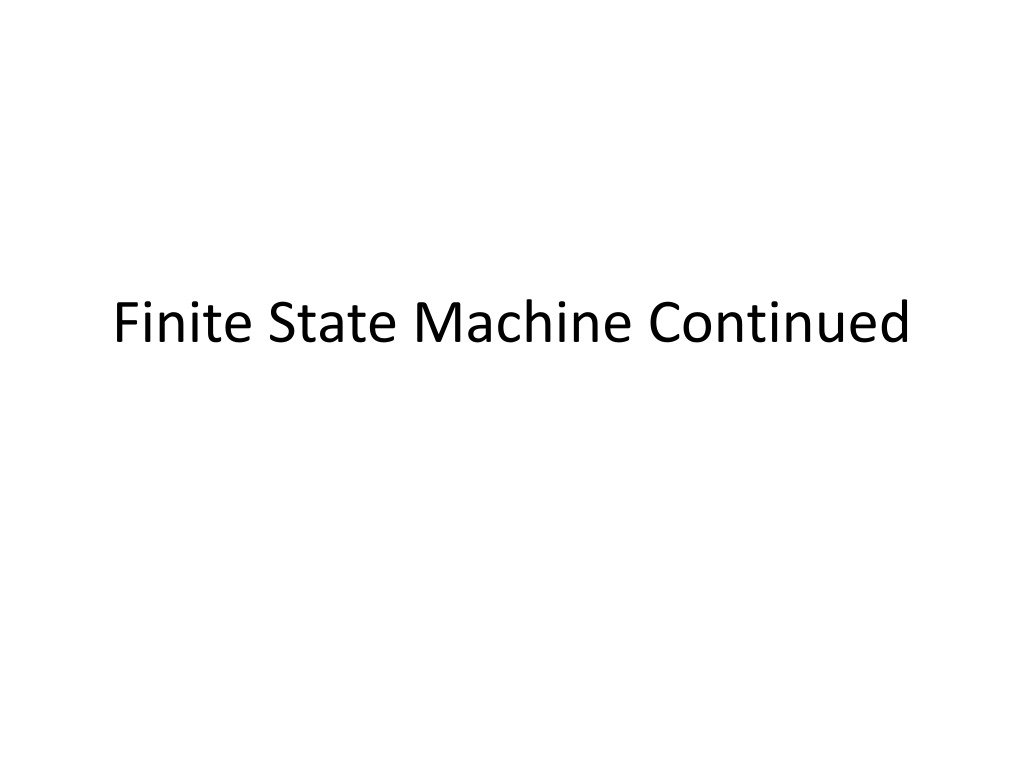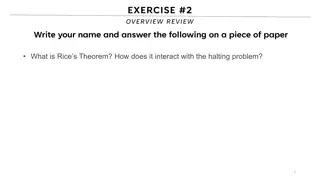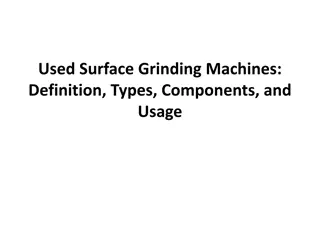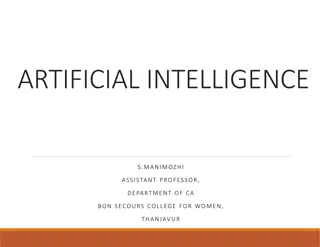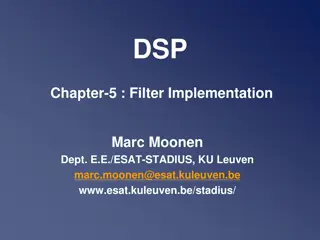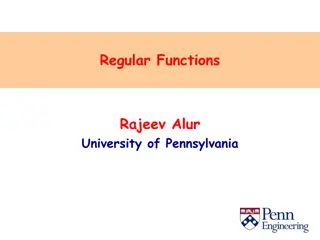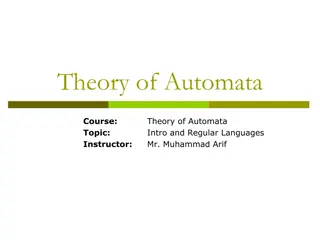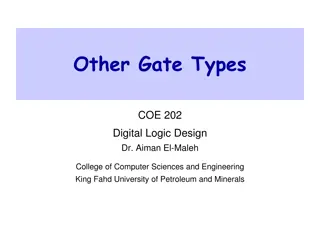Understanding Finite State Machines in Digital Logic Design
Finite state machines play a crucial role in digital logic systems, allowing for the implementation of sequential circuit designs. These machines consist of states and transition functions, determining system behavior based on inputs and current state. The output function generates outputs based on the current state, with Moore machines being a common type. By learning to design and implement finite state machines, one can create intelligent systems like traffic controllers that efficiently manage state transitions and outputs.
Download Presentation

Please find below an Image/Link to download the presentation.
The content on the website is provided AS IS for your information and personal use only. It may not be sold, licensed, or shared on other websites without obtaining consent from the author. Download presentation by click this link. If you encounter any issues during the download, it is possible that the publisher has removed the file from their server.
E N D
Presentation Transcript
In class exercise Design a 2-bit up-down counter with a control signal U. If U=0, count down, else count up.
Combinational and Sequential Circuit Digital logic systems can be classified as combinational or sequential. Combinational circuits can be completely described by the truth table. Sequential systems contain state stored in memory elements internal to the system. Their behavior depends both on the set of inputs supplied and on the contents of the internal memory, or state of the system. Thus, a sequential system cannot be described with a truth table. Instead, a sequential system is described as a finite-state machine (or often just state machine).
Finite State Machines A finite state machine has a set of states and two functions called the next-state function and the output function The set of states correspond to all the possible combinations of the internal storage If there are n bits of storage, there are 2n possible states The next state function is a combinational logic function that given the inputs and the current state, determines the next state of the system 11/10/2007 11:52:10 AM week12-3.ppt 5
Finite State Machines The output function produces a set of outputs from the current state and the inputs There are two types of finite state machines In a Moore machine, the output only depends on the current state While in a Mealy machine, the output depends both the current state and the current input We are only going to deal with the Moore machine. These two types are equivalent in capabilities 11/10/2007 11:52:34 AM week12-3.ppt 6
Implementing an FSM Outputs Inputs Implement transition functions Current state Q D Next state 11/10/2007 11:55:38 AM week12-3.ppt 7
Intelligent Traffic Controller We want to use a finite state machine to control the traffic lights at an intersection of a north-south route and an east- west route We consider only the green and red lights We want the lights to change no faster than 30 seconds in each direction So we use a 0.033 Hz clock 11/10/2007 11:53:59 AM week12-3.ppt 8
Intelligent Traffic Controller There are two output signals NSlite: When the signal is asserted, the light on the north-south route is green; otherwise, it should be red EWlite: When the signal is asserted, the light on the east-west route is green; otherwise, it should be red 11/10/2007 11:54:14 AM week12-3.ppt 9
Intelligent Traffic Controller There are two inputs NScar: Indicates that there is at least one car that is over the detectors placed in the roadbed in the north-south road EWcar: Indicates that there is at least one car that is over the detectors placed in the roadbed in the east-west road 11/10/2007 11:54:22 AM week12-3.ppt 10
Intelligent Traffic Controller The traffic lights should only change from one direction to the other only if there is a car waiting in the other direction Otherwise, the light should continue to show green in the same direction 11/10/2007 11:54:32 AM week12-3.ppt 11
Intelligent Traffic Controller Here we need two states NSgreen: The traffic light is green in the north- south direction EWgreen: The traffic light is green in the east-west direction 11/10/2007 11:54:40 AM week12-3.ppt 12
Graphical Representation EWCar=0, NSCar=0 or 1 NSCar=0, EWCar=0 or 1 NSCar=1, EWCar=0 or 1 NSgreen EWgreen EWCar=1, NSCar=0 or 1 11/10/2007 11:55:01 AM week12-3.ppt 13
Next State Function and Output Function 11/10/2007 11:54:47 AM week12-3.ppt 14
State Assignment We need to assign state numbers to the states In this case, we can assign NSgreen to state 0 and EWgreen to state 1 Therefore we only need 1 bit in the state register 11/10/2007 11:55:05 AM week12-3.ppt 15
Combinational Logic for Next State Function 11/10/2007 11:55:12 AM week12-3.ppt 16
Implementing Intelligent Traffic Controller 11/15/2007 2:38:31 PM week12-5.ppt 17
Four Steps to Build a Finite State Machine Step 1 State diagram and state table There are no set procedures and diagrams. Application dependent Choose a state to be the starting state when power is turned on the first time A state diagram can be represented by a graph or by a table 11/15/2007 2:38:32 PM week12-5.ppt 18
Four Steps to Build a Finite State Machine Step 2 State assignment Assign a unique binary number to each state Rewrite the state table using the assigned number for each state Step 3 Combinational logic for next state function and output function Step 4 - Implementation 11/15/2007 2:38:32 PM week12-5.ppt 19
FSM The state is updated at the edge of the clock cycle The next state is computed once every clock.
Finite State Machine for a Vending Machine Build a custom controller for a vending machine. We could use a general purpose processor, but we might save money with a custom controller. Take coins, give drinks 21
Inputs and Outputs Inputs: coin trigger refund button drink selectors Outputs: drink release latches Coin refund latch 22
Specifications Sells only two kinds of drinks, A,B. (For now, assume all drinks are available in the machine.) All drinks are $0.50. Accepts quarters only. If you put in more than $0.50, consider it as $0.50. Will respond to refund button. If pressed, release all quarters. If the current amount of money is less than $0.50 Will not respond to select buttons. If the current amount of money is $0.50 Will respond to select buttons. If SA is pressed, release drink A, if SB is pressed, release drink B. Then, take in all the money.
Controller Outputs Suppose the latch to be used to build the vending machine is controlled by one bit. It will be closed if the control signal is 0. If the control signal is 1 for a duration of one clock cycle, it will open for a period of time sufficient to allow things stored to fall through; after that, if the control signal is 0, it will be closed. If it is 1, it will stay open until the control signal returns to 0. Controller outputs are: L_A, L_B, L_RF, L_TK. These are signals to control the latches. L_A=1, the latch for drink A opens, and drink A will fall out. L_B=1, the latch for drink B opens, and drink B will fall out. L_RF=1, the latch for coin refund opens, and coins will fall out. L_TK = 1, the latch for coin take opens, and coins will fall from the temporarily storing place to the inside of the machine. Based on the specification of the latches, we need to set the control signals to be 1 for one clock.
Inputs Inputs include some buttons: SA, SB, RF. SA = 1 when the user is pressing the select A button, else it is 0 SB = 1 when the user is pressing the select B button, else it is 0 RF = 1 when the user is pressing the refund button, else it is 0 Inputs also include CIS (coin insert). When a coin is falling in, CIS is 1 for one clock cycle (from one falling edge to the next falling edge). It is 0 all other time.
Design How to design this controller, given the specifications and the inputs and the outputs? Is this a stateless controller, or a controller with states?
State To tell if a controller has states or not, the simplest way is to check if the controller s output is relevant to what happened in the past. If it is relevant, it has state; otherwise it does not. The vending machine controller has state, because the controller s response to the same input (e.g., SA) is different depending on the number of quarters inserted.
Identifying the States We need at least three states to remember how many quarters we have got. S0: The initial state. Got 0 quarters. S1: Got 1 quarter. S2: Got 2 quarters.
State Diagram S0 S1 S2 CIS = 1
State Diagram When got $0.50, if the user presses select button, should release drink, take money, and go back to state S0. But is this diagram correct? S0 S1 S2 CIS = 1 SA = 1
State Diagram Not complete we haven t take action yet. When the SA is pressed, the controller should change some output signal not shown in the diagram S0 S1 S2 CIS = 1 SA = 1
Change the output The output to be changed, clearly, is the L_A and L_TK. By the specification, we should let them be 1 for one clock cycle. clk SA L_A L_TK
Other options Can we just let the latch be controlled by the SA button, meaning that the latch is open when SA is pressed? If we do this, I will just get free drinks. So the latch has to be determined by the states somehow. Can we just say that the latch is open if in state S2 and when SA is pressed? When in state S2, if SA is pressed, the next state is not S2 the overlapping time may not be enough because SA can become 1 at arbitrary time.
The Action State For SA To ensure that the control signal stays high for one clock cycle, we need another state. In S3, L_A = 1 L_TK = 1 S0 S1 S3 S2 CIS = 1 SA = 1 automatic
The complete diagram CIS = 1 RF = 1 SA = 1 SB = 1 S0 S1 automatic S3: L_A=1, L_TK=1 S4: L_B=1, L_TK=1 S3 S2 S5: L_RF=1 S4 S5
